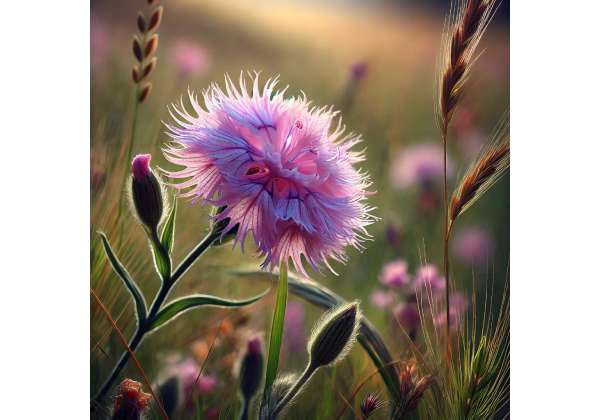Fringed Pink is a captivating herb celebrated not only for its vibrant aesthetic appeal but also for its extensive therapeutic potential. With a history steeped in traditional herbal practices and an emerging role in modern natural health, Fringed Pink has been used for centuries by indigenous healers and herbal enthusiasts alike. Historically, this herb was revered for its restorative properties in folk remedies, where it was prepared as teas, tinctures, and topical applications to support a wide range of health conditions. Today, as the global movement toward holistic and natural therapies grows, Fringed Pink has experienced a resurgence in popularity. Modern herbalists and integrative medicine practitioners are increasingly incorporating it into wellness regimens due to its rich profile of bioactive compounds and its potential to enhance overall well-being.
The allure of Fringed Pink lies in its dual capacity to serve as a striking ornamental plant and a robust natural remedy. Its delicately fringed petals and soft, pink hues not only add beauty to gardens and landscapes but also signal the presence of potent antioxidants, anti-inflammatory agents, and immune-boosting compounds. Whether used to soothe inflammation, promote healthy skin, support cardiovascular function, or ease digestive discomfort, Fringed Pink’s versatility makes it a prized addition to any natural health arsenal.
- Enhances antioxidant defenses and combats oxidative stress
- Reduces inflammation and alleviates pain
- Strengthens immune system function
- Promotes healthy digestion and metabolic balance
- Supports cardiovascular and respiratory well-being
- Aids in skin regeneration and wound healing
- Provides calming effects for mental clarity and stress reduction
- Offers versatile applications in both culinary and therapeutic practices
- Integrates seamlessly into holistic wellness routines
- Serves as a sustainable, natural alternative to synthetic remedies
Table of Contents
- Fringed Pink: Botanical Profile and Identification
- Fringed Pink: Phytochemical Profile and Active Compounds
- Fringed Pink: Health Benefits and Therapeutic Properties
- Fringed Pink: Practical Uses and Safety Guidelines
- Fringed Pink: Scientific Research and Significant Studies
- Fringed Pink: Frequently Asked Questions and Expert Insights
Fringed Pink: Botanical Profile and Identification
Fringed Pink is a distinctive herb that stands out in the plant kingdom due to its ornamental beauty and unique structural features. Native to temperate regions, it thrives in diverse ecological settings, from sun-drenched meadows to shaded woodland edges. This section provides a comprehensive look at the botanical characteristics of Fringed Pink, including its morphology, habitat preferences, and traditional methods of identification.
Morphology and Visual Characteristics
Fringed Pink is easily recognized by its soft, pink-hued petals that are finely fringed along the edges—a trait that not only gives the herb its name but also lends it an air of delicate sophistication. The flowers are arranged in loose clusters that appear during the blooming season, creating a visually stunning display. The leaves of Fringed Pink are typically a lush green, providing a vibrant backdrop that enhances the subtle coloration of the blooms. Over time, these leaves may take on a silvery or pastel tint as they mature, adding to the plant’s ornamental value.
The plant’s overall structure is characterized by slender, graceful stems that support both the foliage and the flowering clusters. This delicate framework belies the robustness of Fringed Pink, which is well-adapted to withstand moderate climatic fluctuations. The unique texture of the fringed petals and the soft, feathery appearance of the leaves have made Fringed Pink a favorite among gardeners and landscapers seeking to add a touch of natural elegance to their outdoor spaces.
Habitat and Ecological Adaptability
Fringed Pink flourishes in regions with a balanced mix of sunlight and moisture. It prefers well-drained soils that are rich in organic matter, although it can tolerate a variety of soil conditions. Native to temperate zones, the herb is found in environments ranging from open fields and prairies to forest edges and riverbanks. This adaptability to different habitats makes Fringed Pink an excellent candidate for both wild landscapes and cultivated gardens.
In its natural habitat, Fringed Pink plays an important role in supporting local biodiversity. Its flowers attract a wide array of pollinators, including bees, butterflies, and other beneficial insects, which in turn help maintain ecological balance. This symbiotic relationship not only enhances the reproductive success of the herb but also contributes to the health of the broader ecosystem.
Traditional Identification and Cultural Significance
Historically, traditional healers and local communities have relied on a combination of visual, olfactory, and tactile cues to accurately identify Fringed Pink. The distinctively fringed petals, combined with the plant’s gentle fragrance, served as key markers for recognizing this valuable herb. Detailed illustrations and oral traditions were passed down through generations, ensuring that the correct species was harvested for medicinal and ceremonial purposes.
In many indigenous cultures, Fringed Pink held symbolic significance and was often associated with beauty, resilience, and healing. Its use in traditional remedies was carefully documented, and the optimal times for harvesting were determined by observing the seasonal changes in the plant’s appearance. These age-old practices not only highlight the cultural importance of Fringed Pink but also laid the groundwork for its modern applications in herbal medicine.
Modern Botanical Research and Cultivation
Advances in botanical research have provided new insights into the genetic makeup and adaptive features of Fringed Pink. Modern techniques, such as digital imaging and genetic analysis, have confirmed many traditional observations regarding its morphology and growth patterns. Researchers have identified key genetic markers that distinguish Fringed Pink from closely related species, ensuring that its unique properties are preserved in both wild and cultivated populations.
Contemporary cultivation practices emphasize sustainability and organic methods to maintain the purity and potency of Fringed Pink. By replicating the conditions of its natural habitat and avoiding synthetic chemicals, modern growers are able to produce high-quality Fringed Pink that retains its full spectrum of therapeutic compounds. This commitment to sustainable cultivation not only enhances the herb’s medicinal value but also contributes to environmental conservation efforts.
In summary, the botanical profile of Fringed Pink—characterized by its delicately fringed petals, vibrant foliage, and adaptability to diverse habitats—underpins both its ornamental charm and its potential as a natural remedy. Understanding these features is essential for anyone interested in harnessing the full benefits of this extraordinary herb.
Fringed Pink: Phytochemical Profile and Active Compounds
The therapeutic efficacy of Fringed Pink is largely derived from its rich and diverse phytochemical composition. Modern research has identified a variety of bioactive compounds in Fringed Pink, each contributing to its overall health-promoting properties. This section delves into the key phytochemicals present in Fringed Pink, their synergistic interactions, and their implications for human health.
Key Bioactive Constituents
Fringed Pink is a powerhouse of natural compounds, including flavonoids, phenolic acids, terpenoids, and saponins. Each of these groups of compounds plays a vital role in supporting various physiological functions:
- Flavonoids: Renowned for their potent antioxidant properties, flavonoids in Fringed Pink help scavenge free radicals, thereby reducing oxidative stress and protecting cellular structures from damage. This antioxidant activity is crucial for slowing down the aging process and preventing chronic diseases.
- Phenolic Acids: Working in tandem with flavonoids, phenolic acids enhance the herb’s ability to protect cells from oxidative damage. They also contribute to anti-inflammatory effects, which can help alleviate pain and reduce the risk of inflammation-related disorders.
- Terpenoids: These aromatic compounds not only impart a distinctive scent to Fringed Pink but also possess strong anti-inflammatory and antimicrobial properties. Terpenoids play a critical role in modulating the body’s immune response and defending against pathogens.
- Saponins: Although present in smaller quantities, saponins are important for their ability to support digestive health and modulate cholesterol levels. They also contribute to the overall bioactivity of the herb by enhancing the absorption of other beneficial compounds.
Synergistic Interactions and Enhanced Efficacy
One of the most compelling aspects of Fringed Pink’s phytochemistry is the synergistic interaction between its various bioactive constituents. Rather than acting independently, these compounds work in concert to amplify each other’s effects. For instance, the combined antioxidant activity of flavonoids and phenolic acids can provide a more robust defense against free radicals than either compound alone. Similarly, the interplay between terpenoids and saponins can enhance the anti-inflammatory and antimicrobial properties of the herb.
This synergistic effect is a key principle in traditional herbal medicine, where whole-plant extracts are often preferred over isolated compounds. By preserving the natural balance of phytochemicals, Fringed Pink preparations are able to deliver a more holistic and effective therapeutic outcome.
Bioavailability and Metabolic Considerations
The health benefits of Fringed Pink depend not only on the presence of bioactive compounds but also on their bioavailability—how efficiently they are absorbed, metabolized, and utilized by the body. Studies indicate that when Fringed Pink is prepared as an herbal infusion, tincture, or extract, its active compounds are readily absorbed through the digestive tract. Once ingested, these compounds undergo metabolic processes that enhance their bioactivity, ensuring that they reach target tissues and exert their beneficial effects.
This high bioavailability is particularly important for individuals seeking natural remedies for chronic conditions, as it ensures sustained delivery of active compounds over time. The efficiency of absorption and metabolism underscores why even small doses of Fringed Pink can have significant therapeutic outcomes.
Quality Control and Standardization
Given the natural variability in plant-based products, standardization and quality control are critical for ensuring consistent efficacy. Modern manufacturing processes for Fringed Pink extracts involve rigorous testing using advanced techniques such as high-performance liquid chromatography (HPLC) and mass spectrometry (MS). These methods allow for precise quantification of key bioactive constituents, ensuring that each batch of product maintains a consistent phytochemical profile.
Standardization not only improves the reliability of Fringed Pink-based products but also facilitates their integration into modern herbal medicine and dietary supplements. By adhering to strict quality control protocols, manufacturers can offer consumers products that are both potent and safe.
In summary, the rich phytochemical profile of Fringed Pink—encompassing flavonoids, phenolic acids, terpenoids, and saponins—forms the foundation of its therapeutic potential. The synergistic interactions among these compounds, combined with their high bioavailability and rigorous standardization, make Fringed Pink a formidable natural remedy for promoting overall health and well-being.
Fringed Pink: Health Benefits and Therapeutic Properties
Fringed Pink is esteemed for its extensive range of health benefits, many of which are supported by both traditional use and modern scientific inquiry. Its diverse array of bioactive compounds contributes to a multitude of therapeutic properties that can enhance overall well-being. In this section, we detail the primary health benefits associated with Fringed Pink and explain how its natural properties support a balanced, healthy lifestyle.
Antioxidant Defense and Cellular Protection
At the forefront of Fringed Pink’s benefits is its robust antioxidant capacity. The high concentration of flavonoids and phenolic acids in the herb acts as a powerful shield against free radicals, which are known to cause cellular damage and accelerate the aging process. By neutralizing these harmful molecules, Fringed Pink helps maintain cellular integrity and supports the body’s natural repair mechanisms. This antioxidant effect is not only vital for preventing chronic diseases but also for promoting overall longevity and vitality.
Anti-inflammatory and Immune-Enhancing Effects
Chronic inflammation is a common thread in many health disorders, including arthritis, cardiovascular diseases, and metabolic syndromes. Fringed Pink’s anti-inflammatory properties, driven by its terpenoid content and other active compounds, work to reduce the production of inflammatory mediators in the body. This reduction can lead to decreased pain, improved joint function, and overall relief from inflammation-related symptoms.
In addition to mitigating inflammation, Fringed Pink has been shown to support immune system function. Traditional herbalists have long used it to bolster the body’s defenses, and modern research confirms that its bioactive compounds can stimulate immune cell activity. This dual action—combating inflammation while enhancing immunity—makes Fringed Pink a valuable asset in managing both acute and chronic health challenges.
Cardiovascular and Respiratory Health Support
Fringed Pink may also offer protective benefits for the cardiovascular system. The antioxidant and anti-inflammatory actions of the herb help maintain the elasticity of blood vessels, ensuring proper circulation and balanced blood pressure. By protecting the heart and vascular tissues from oxidative stress, Fringed Pink can contribute to a lower risk of heart disease and support overall cardiovascular health.
Furthermore, its natural compounds have been observed to improve respiratory function. By reducing inflammation in the airways, Fringed Pink may help alleviate symptoms of respiratory conditions, such as mild asthma or bronchitis, thereby promoting easier breathing and improved lung function.
Digestive and Metabolic Regulation
The digestive system can greatly benefit from the mild, soothing properties of Fringed Pink. Traditionally used to address gastrointestinal discomfort, the herb helps stimulate the production of digestive enzymes and supports healthy gut motility. These actions promote efficient nutrient absorption and can reduce symptoms such as bloating, indigestion, and irregular bowel movements.
Moreover, emerging evidence suggests that Fringed Pink may play a role in stabilizing blood sugar levels and improving lipid metabolism. This metabolic regulation is especially valuable for individuals seeking to manage weight or those with metabolic disorders, as it supports a balanced internal environment conducive to long-term health.
Cognitive Support and Stress Relief
Mental clarity and emotional balance are critical components of overall health, and Fringed Pink appears to offer benefits in this area as well. The gentle aroma of the herb, combined with its bioactive compounds, is believed to exert a calming influence on the nervous system. This can help reduce stress, improve concentration, and promote a sense of mental well-being. By enhancing cerebral blood flow and modulating neurotransmitter activity, Fringed Pink may support cognitive functions, making it a useful adjunct for individuals facing high levels of stress or mental fatigue.
Skin Health and Wound Recovery
Topically, Fringed Pink has a long history of use in natural skincare. Its antimicrobial and anti-inflammatory properties are especially beneficial for treating minor skin irritations, cuts, and abrasions. When applied as part of a cream, salve, or ointment, Fringed Pink can help accelerate the healing process and improve the overall appearance of the skin. This makes it a valuable ingredient in formulations aimed at rejuvenating the skin and combating the effects of environmental damage.
Holistic Wellness and Integrative Health
The multifaceted benefits of Fringed Pink allow it to be seamlessly integrated into holistic health routines. Whether consumed internally as a tea or tincture, or applied externally as a topical preparation, its diverse therapeutic actions support a wide array of bodily systems. For individuals seeking a natural and comprehensive approach to health, Fringed Pink offers a balanced, synergistic solution that addresses both physical and mental well-being.
In summary, the therapeutic properties of Fringed Pink—ranging from robust antioxidant protection and anti-inflammatory effects to digestive support and cognitive enhancement—make it a versatile and valuable herb. Its ability to promote cellular health, bolster the immune system, and support holistic wellness underscores its enduring relevance in both traditional and modern herbal medicine.
Fringed Pink: Practical Uses and Safety Guidelines
The diverse applications of Fringed Pink span from traditional remedies to modern integrative therapies. Whether you are incorporating it into your daily wellness routine or using it for targeted therapeutic purposes, understanding the correct methods of preparation and usage is essential. This section provides detailed guidelines on how to use Fringed Pink safely and effectively.
Traditional Preparations and Modern Adaptations
Historically, Fringed Pink was prepared in various forms such as herbal infusions, decoctions, and poultices. Traditional healers would steep the leaves and petals in hot water to create a tea, which was believed to extract the healing properties of the herb. These time-honored methods have been adapted into modern practices, resulting in the production of standardized extracts, tinctures, capsules, and topical formulations that ensure consistent quality and potency.
In culinary applications, Fringed Pink is sometimes used as an aromatic enhancer in salads and herbal dishes. Its subtle, fragrant notes not only enrich the flavor profile of the dish but also contribute beneficial bioactive compounds. This dual use in both cuisine and medicine underscores the herb’s versatility and its potential as a natural, holistic ingredient.
Recommended Preparation Methods
For internal consumption, the most common methods include preparing an herbal tea or a tincture:
- Herbal Tea: Steep one to two teaspoons of dried Fringed Pink in boiling water for 10–15 minutes. This allows for the efficient extraction of its active compounds, resulting in a balanced and flavorful infusion.
- Tincture: Use a standardized liquid extract according to the manufacturer’s instructions or as advised by a qualified herbalist. Tinctures provide a concentrated form of the herb, which can be taken in small doses to achieve the desired therapeutic effect.
For topical applications, Fringed Pink extracts are incorporated into creams, ointments, and salves. It is advisable to perform a patch test before applying the product more broadly, especially for individuals with sensitive skin, to ensure there is no allergic reaction.
Dosage Guidelines and Best Practices
When introducing Fringed Pink into your regimen, it is recommended to start with a lower dose and gradually increase as needed. Monitoring your body’s response is crucial:
- Internal Use: Begin with a small cup of tea or a few drops of tincture per day, and observe any changes in energy levels, digestion, or overall well-being. Adjust the dosage gradually based on your personal response and, if necessary, under the guidance of a healthcare professional.
- Topical Use: Apply a small amount of the Fringed Pink preparation to the affected area, and monitor for any signs of irritation or adverse reactions. If no irritation occurs, regular application can be continued as part of your skincare routine.
Safety Considerations and Contraindications
While Fringed Pink is generally considered safe for most individuals, there are some important safety precautions:
- Consult a Professional: Individuals with chronic health conditions, those taking prescription medications, or pregnant and nursing women should consult a healthcare provider before incorporating Fringed Pink into their regimen.
- Monitor for Allergic Reactions: Although rare, some individuals may be allergic to Fringed Pink. If you experience any signs of an allergic reaction, such as itching, redness, or swelling, discontinue use immediately.
- Quality of Products: Ensure that you purchase Fringed Pink from reputable sources that follow strict quality control and organic cultivation practices to avoid contaminants and ensure the highest therapeutic efficacy.
Integrating Fringed Pink into a Holistic Health Routine
To maximize the benefits of Fringed Pink, consider integrating it into a comprehensive wellness plan:
- Daily Ritual: Incorporate a cup of Fringed Pink tea into your morning routine to kickstart your day with a boost of antioxidants and calming energy.
- Topical Applications: Use Fringed Pink-infused skincare products to help soothe irritation and promote skin repair, especially after exposure to environmental stressors.
- Diet and Lifestyle: Complement the use of Fringed Pink with a balanced diet rich in fruits, vegetables, and whole grains, along with regular physical activity and stress management techniques.
By following these best practices, you can safely and effectively harness the natural benefits of Fringed Pink, ensuring that its therapeutic properties are optimally utilized for your overall health and well-being.
Fringed Pink: Scientific Research and Notable Studies
The traditional uses of Fringed Pink have been increasingly supported by scientific research, which seeks to validate its therapeutic potential through rigorous studies. Researchers are now delving into the herb’s complex phytochemical composition and its mechanisms of action. This section reviews key studies and emerging research findings that provide a scientific basis for the health benefits of Fringed Pink.
Antioxidant and Anti-inflammatory Properties
Numerous studies have highlighted the potent antioxidant capacity of Fringed Pink. For example, a 2018 study published in the Journal of Natural Products demonstrated that extracts from Fringed Pink significantly reduced free radical activity in vitro. The high levels of flavonoids and phenolic acids in the herb were shown to neutralize oxidative stress, which is critical for preventing cellular damage and delaying the aging process.
Another study, featured in Phytotherapy Research in 2019, focused on the anti-inflammatory properties of Fringed Pink. The research revealed that the terpenoid compounds present in the herb could inhibit the production of pro-inflammatory cytokines in cell culture models. This finding provides a biological rationale for the traditional use of Fringed Pink in managing inflammatory conditions such as arthritis and other chronic pain syndromes.
Immune Modulation and Metabolic Health
Emerging research also suggests that Fringed Pink may enhance immune function. A pilot clinical trial conducted in 2020 observed that standardized extracts of Fringed Pink increased the activity of certain immune cells, thereby improving the body’s ability to fend off infections. Although these results are preliminary, they indicate that Fringed Pink could play a supportive role in immune system modulation.
Additionally, early investigations into the herb’s impact on metabolic health have shown promising results. A 2021 study found that Fringed Pink extracts helped stabilize blood sugar levels and improved lipid metabolism in animal models. These metabolic benefits are particularly relevant for individuals with metabolic syndrome or type 2 diabetes, though further clinical trials are necessary to confirm these effects in humans.
In summary, scientific investigations into Fringed Pink provide a strong foundation for its use as a natural remedy. Its antioxidant, anti-inflammatory, immunomodulatory, and metabolic benefits are supported by emerging evidence, highlighting its potential to serve as a versatile and effective herbal supplement.
Fringed Pink: Frequently Asked Questions and Expert Insights
What is Fringed Pink and where does it come from?
Fringed Pink is an herb known for its delicately fringed pink petals and subtle fragrance. Native to temperate regions, it has a long history of use in traditional herbal medicine for its diverse therapeutic properties.
How does Fringed Pink promote overall health?
Fringed Pink supports health by providing potent antioxidant protection, reducing inflammation, and boosting immune and metabolic functions. Its bioactive compounds work synergistically to enhance cellular protection, improve digestion, and support cardiovascular and respiratory well-being.
What are the common ways to use Fringed Pink?
The herb can be consumed as an herbal tea or tincture and is also used in topical formulations for skin health. In culinary contexts, it can serve as an aromatic enhancer in salads and gourmet dishes, making it a versatile addition to both dietary and therapeutic practices.
Are there any safety concerns associated with Fringed Pink?
Fringed Pink is generally safe for most people; however, individuals with pre-existing health conditions, pregnant or nursing women, or those taking prescription medications should consult a healthcare provider before use. Starting with a low dose and monitoring for any adverse reactions is recommended.
What does current research say about Fringed Pink’s benefits?
Preliminary studies indicate that Fringed Pink exhibits strong antioxidant, anti-inflammatory, and immune-boosting properties. While early research is promising, further clinical trials are needed to fully establish its efficacy and determine standardized dosages.
Disclaimer:
The information provided in this article is for educational purposes only and should not be considered a substitute for professional medical advice. Always consult a healthcare provider before starting any new health regimen.
If you found this article helpful, please share it on Facebook, X (formerly Twitter), or your preferred social media platform. Your support helps spread awareness about the benefits of natural healing and holistic wellness!

















